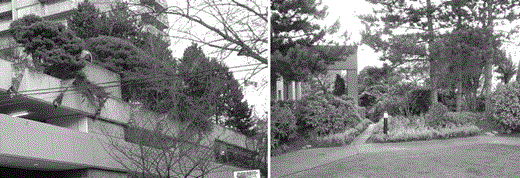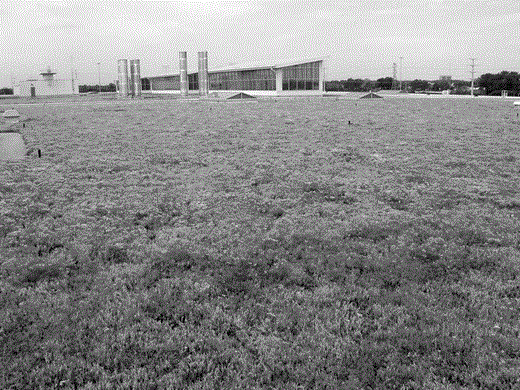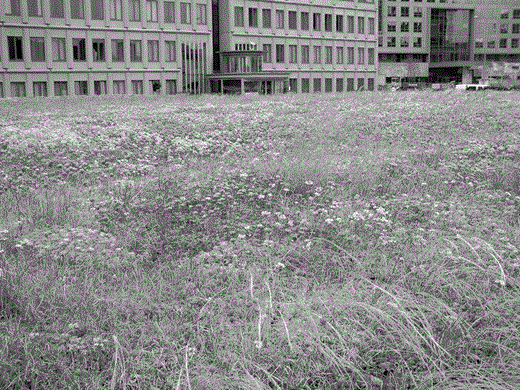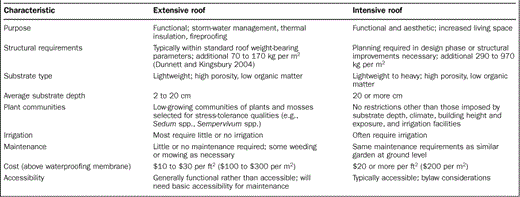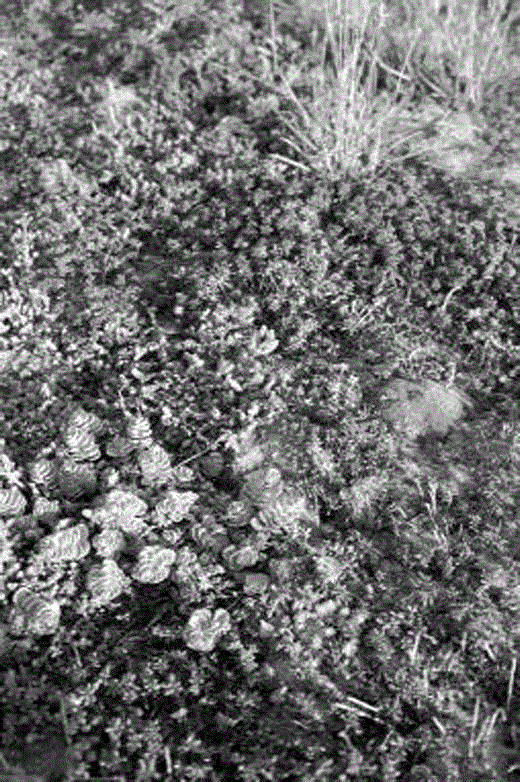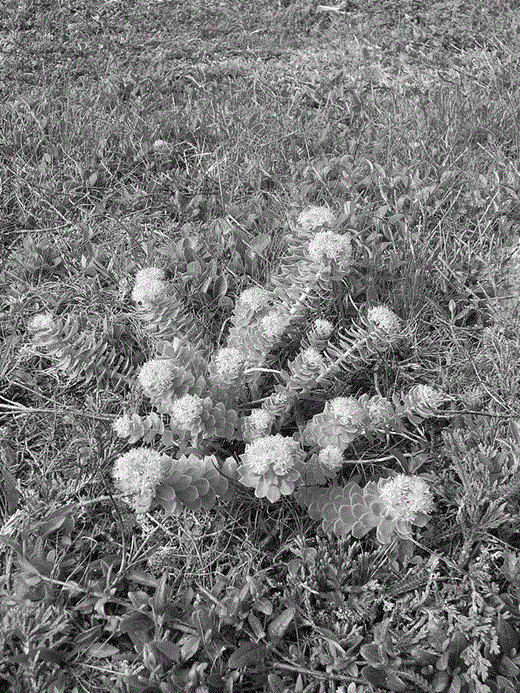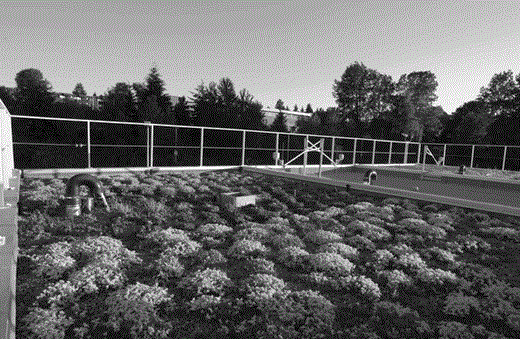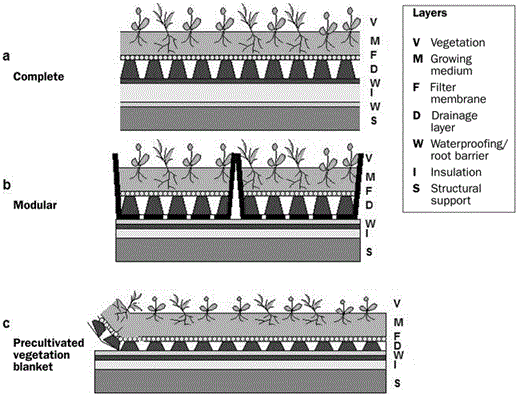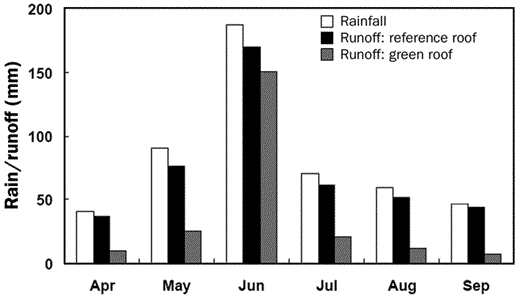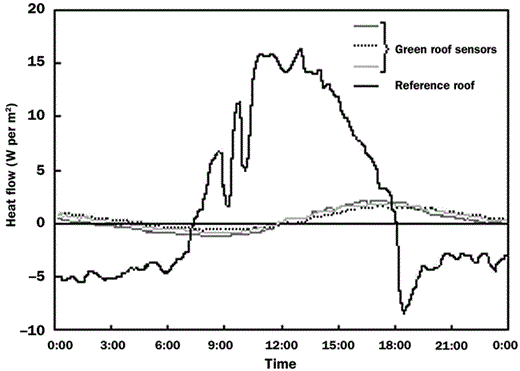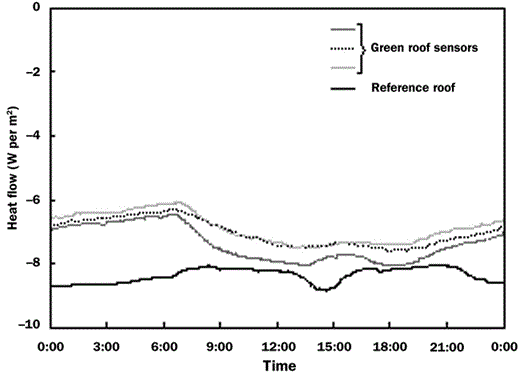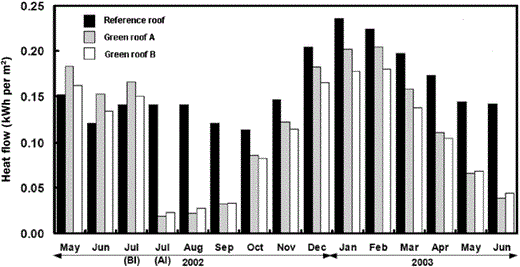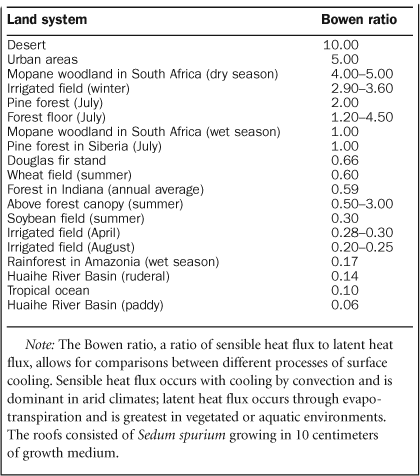-
PDF
- Split View
-
Views
-
Cite
Cite
Erica Oberndorfer, Jeremy Lundholm, Brad Bass, Reid R. Coffman, Hitesh Doshi, Nigel Dunnett, Stuart Gaffin, Manfred Köhler, Karen K. Y. Liu, Bradley Rowe, Green Roofs as Urban Ecosystems: Ecological Structures, Functions, and Services, BioScience, Volume 57, Issue 10, November 2007, Pages 823–833, https://doi.org/10.1641/B571005
Close - Share Icon Share
Abstract
Abstract
Green roofs (roofs with a vegetated surface and substrate) provide ecosystem services in urban areas, including improved storm-water management, better regulation of building temperatures, reduced urban heat-island effects, and increased urban wildlife habitat. This article reviews the evidence for these benefits and examines the biotic and abiotic components that contribute to overall ecosystem services. We emphasize the potential for improving green-roof function by understanding the interactions between its ecosystem elements, especially the relationships among growing media, soil biota, and vegetation, and the interactions between community structure and ecosystem functioning. Further research into green-roof technology should assess the efficacy of green roofs compared to other technologies with similar ends, and ultimately focus on estimates of aggregate benefits at landscape scales and on more holistic cost-benefit analyses.
Buildings change the flow of energy and matter through urban ecosystems, often causing environmental problems. These problems can be partially mitigated by altering the buildings' surficial properties. Roofs can represent up to 32% of the horizontal surface of built-up areas (Frazer 2005) and are important determinants of energy flux and of buildings' water relations. The addition of vegetation and soil to roof surfaces can lessen several negative effects of buildings on local ecosystems and can reduce buildings' energy consumption. Living, or green, roofs have been shown to increase sound insulation (Dunnett and Kingsbury 2004), fire resistance (Köhler 2003), and the longevity of the roof membrane (Porsche and Köhler 2003). They can reduce the energy required for the maintenance of interior climates (Del Barrio 1998), because vegetation and growing plant media intercept and dissipate solar radiation. Green roofs can also mitigate storm-water runoff from building surfaces by collecting and retaining precipitation, thereby reducing the volume of flow into storm-water infrastructure and urban waterways. Other potential benefits include green-space amenity, habitat for wildlife, air-quality improvement, and reduction of the urban heat-island effect (Getter and Rowe 2006). Architects have applied green-roof technology worldwide, and policymakers and the public are becoming more aware of green-roof benefits. Although green roofs are initially more expensive to construct than conventional roofs, they can be more economical over the life span of the roof because of the energy saved and the longevity of roof membranes (Porsche and Köhler 2003).
Although green roofs represent a distinct type of urban habitat, they have been treated largely as an engineering or horticultural challenge, rather than as ecological systems. The environmental benefits provided by green roofs derive from their functioning as ecosystems. The first goal of this article is to describe the history and components of living-roof ecosystems; the second is to review the ways in which the structure of a green roof—including vegetation, growing medium, and roof membrane—determines its functions.
History of green roofs
Roof gardens, the precursors of contemporary green roofs, have ancient roots. The earliest documented roof gardens were the hanging gardens of Semiramis in what is now Syria, considered one of the seven wonders of the ancient world. Today, similarly elaborate roof-garden projects are designed for high-profile international hotels, business centers, and private homes. These green roofs, known for their deep substrates and variety of plantings as “intensive” green roofs, have the appearance of conventional ground-level gardens, and they can augment living and recreation space in densely populated urban areas (figure 1, table 1). Intensive green roofs typically require substantial investments in plant care. Furthermore, they emphasize the active use of space and carry higher aesthetic expectations than “extensive” green roofs, which generally have shallower soil and low-growing ground cover.
Extensive green roofs are a modern modification of the roof-garden concept. They typically have shallower substrates, require less maintenance, and are more strictly functional in purpose than intensive living roofs or roof gardens (figure 1, table 1; Dunnett and Kingsbury 2004). In their simplest design, extensive green roofs consist of an insulation layer, a waterproofing membrane, a layer of growing medium, and a vegetation layer. This basic green-roof design has been implemented and studied in diverse regions and climates worldwide.
The modern green roof originated at the turn of the 20th century in Germany, where vegetation was installed on roofs to mitigate the damaging physical effects of solar radiation on the roof structure. Early green roofs were also employed as fire-retardant structures (Köhler 2003). There are now several competing types of extensive green-roof systems, which provide similar functions but are composed of different materials and require different implementation protocols (figure 1).
In the 1970s, growing environmental concern, especially in urban areas, created opportunities to introduce progressive environmental thought, policy, and technology in Germany. Green-roof technology was quickly embraced because of its broad-ranging environmental benefits, and interdisciplinary research led to technical guidelines, the first volume of which was published in 1982 by the Landscape, Research, Development and Construction Society (FLL 2002). Many German cities have since introduced incentive programs to promote green-roof technology and improve environmental standards. Building law now requires the construction of green roofs in many urban centers (Köhler and Keeley 2005). Such legal underpinnings of green-roof construction have had a major effect on the widespread implementation and success of green-roof technology throughout Germany. Green-roof coverage in Germany alone now increases by approximately 13.5 million square meters (m2) per year. Haemmerle (2002) calculates that approximately 14% of all new flat roofs in Germany will be green roofs; the total area covered by green roofs is unknown. The market for sloped green roofs is also developing rapidly, and accessible green roofs have become a driving force in neighborhood revitalization.
Green-roof vegetation
Rooftop conditions are challenging for plant survival and growth. Moisture stress and severe drought, extreme (usually elevated) temperatures, high light intensities, and high wind speeds increase the risk of desiccation and physical damage to vegetation and substrate (Dunnett and Kingsbury 2004). Plants suitable for extensive green roofs share adaptations that enable them to survive in harsh conditions. These plants have stress-tolerant characteristics (sensuGrime 2001), including low, mat-forming or compact growth; evergreen foliage or tough, twiggy growth; and other drought-tolerance or avoidance strategies, such as succulent leaves, water storage capacity, or CAM (crassulacean acid metabolism) physiology (figure 2; Lee and Kim 1994). However, frequent drought-related disturbance to green-roof vegetation also favors some ruderal species (sensuGrime 2001) that can rapidly occupy gaps. Green-roof communities are dynamic, and with time, vegetation is likely to change from the original composition (Köhler 2006).
Since the 1980s, researchers have tested many herbaceous and woody taxa in different rooftop conditions (Heinze 1985, Boivin et al. 2001, Köhler 2003, Durhman et al. 2004, Monterusso et al. 2005). Heinze (1985) compared combinations of various Sedum species, grasses, and herbaceous perennials, planted at two substrate depths in simulated roof platforms. Sedum species outperformed the other taxa, except in consistently moist substrate deeper than 10 centimeters (cm). In these conditions, a taller grass and herbaceous canopy layer created shaded conditions that proved unfavorable to the Sedum species. Other studies support the suitability of low-growing Sedum species for use in green roofs because of their superior survival in substrate layers as thin as 2 to 3 cm (VanWoert et al. 2005a). Physical rooftop conditions, suitability for plant growth, and the cost of various substrates have also been examined (Dunnett and Nolan 2004, Rowe et al. 2006).
The composition and character of green-roof vegetation depend on many factors. To a large extent, substrate depth dictates vegetation diversity and the range of possible species. Shallow substrate depths between 2 and 5 cm have more rapid rates of desiccation and are more subject to fluctuations in temperature, but can support simple Sedum–moss communities. Substrate depths of 7 to 15 cm can support more diverse mixtures of grasses, geophytes, alpines, and drought-tolerant herbaceous perennials, but are also more hospitable for undesirable weeds.
Green-roof substrates tend to be highly mineral based, with small amounts of organic matter (approximately 10% by weight). The mineral component may come from a variety of sources, and can be of varying weight depending on the load capacity of the roof. Light expanded clay granules and crushed brick are two common materials. There is increasing interest in the use of locally derived lightweight granular waste materials as sustainable sources for green-roof substrates.
Climatic conditions, especially rainfall and extreme temperatures, may restrict the use of certain species or dictate the use of irrigation. Native plants are generally considered ideal choices for landscapes because of their adaptations to local climates, and the native stress-tolerant floras (particularly dry grassland, coastal, and alpine floras) of many regions offer opportunities for trial and experiment. Furthermore, policies for biodiversity and nature conservation may favor the establishment of locally distinctive and representative plant communities. Unfortunately, many native plants appear to be unsuitable for conventional extensive green-roof systems because of the roofs' harsh environmental conditions and typically shallow substrate depths. In a study at Michigan State University, only 4 of the original 18 native prairie perennial species growing in 10 cm of substrate persisted after three years. In comparison, all 9 nonnative species of Sedum used in the study thrived (Monterusso et al. 2005).
In theory, almost any plant taxon could be used for green-roof applications, assuming it is suited to the climatic region, grown in appropriate substrate at an adequate depth, and given adequate irrigation. Wind stress resulting from building height and form may affect the selection of plants, and visibility and accessibility are other selection criteria. Although Sedum remains the most commonly used genus for green roofs, the scope for green-roof vegetation is wide, and many possibilities have yet to be realized.
Ecosystem services provided by green roofs
The green-roof benefits investigated to date fall into three main categories: storm-water management, energy conservation, and urban habitat provision. These ecosystem services derive from three main components of the living roof system: vegetation, substrate (growing medium), and membranes (figure 3). Plants shade the roof surface and transpire water, cooling and transporting water back into the atmosphere. The growing medium is essential for plant growth but also contributes to the retention of storm water. The membranes are responsible for waterproofing the roof and preventing roof penetration by roots.
Storm-water management.
Urban areas are dominated by hard, nonporous surfaces that contribute to heavy runoff, which can overburden existing storm-water management facilities and cause combined sewage overflow into lakes and rivers. In addition to exacerbating flooding, erosion, and sedimentation, urban runoff is also high in pollutants such as pesticides and petroleum residues, which harm wildlife habitats and contaminate drinking supplies (Moran et al. 2005).
Conventional storm-water management techniques include storage reservoirs and ponds, constructed wetlands, and sand filters; however, these surface-area intensive technologies may be difficult to implement in dense urban centers (Mentens et al. 2005). Green roofs are ideal for urban storm-water management because they make use of existing roof space and prevent runoff before it leaves the lot. Green roofs store water during rainfall events, delaying runoff until after peak rainfall and returning precipitation to the atmosphere through evapotranspiration (figure 4; Mentens et al. 2005, Moran et al. 2005). The depth of substrate, the slope of the roof, the type of plant community, and rainfall patterns affect the rate of runoff (Dunnett and Kingsbury 2004, Mentens et al. 2005, VanWoert et al. 2005b). Studies in Portland, Oregon, and East Lansing, Michigan, showed that rainfall retention from specific green roofs was 66% to 69% for roofs with more than 10 cm of substrate (Moran et al. 2005). Rainfall retention varied from 25% to 100% for shallower substrates in other studies (Beattie and Berghage 2004). Green roofs can reduce annual total building runoff by as much as 60% to 79% (Köhler et al. 2002), and estimates based on 10% green-roof coverage suggest that they can reduce overall regional runoff by about 2.7% (Mentens et al. 2005). In general, total runoff is greater with shallower substrate and steeper slopes (Mentens et al. 2005, Villarreal and Bengtsson 2005). Although green roofs can reduce runoff, they do not solve the problem of reduced recharge of ground-water in urban areas.
Improving roof membrane longevity.
Waterproofing membranes on conventional dark roofs deteriorate rapidly in ultraviolet (UV) light, which causes the membranes to become brittle. Such membranes are consequently more easily damaged by the expansion and contraction caused by widely fluctuating roof temperatures. By physically protecting against UV light and reducing temperature fluctuations, green roofs extend the life span of the roof's waterproofing membrane and improve building energy conservation. Temperature stabilization of the waterproofing membranes by green-roof coverage may extend their useful life by more than 20 years (USEPA 2000); some green roofs in Berlin have lasted 90 years without needing major repairs (Porsche and Köhler 2003). In Ottawa, Canada, Liu (2004) found that an unvegetated reference roof reached temperatures higher than 70 degrees Celsius (°C) in summer, while the surface temperature of the green roof only reached 30°C. The membrane on the reference roof reached 30°C on 342 of the 660 days of the study, whereas the membrane underneath the green roof only reached that temperature on 18 days (figure 5).
Summer cooling.
During warm weather, green roofs reduce the amount of heat transferred through the roof, thereby lowering the energy demands of the building's cooling system (Del Barrio 1998, Theodosiou 2003). Wong and colleagues (2003) found that the heat transfer through a green roof in Singapore over a typical day was less than 10% of that of a reference roof. Research in Japan (Onmura et al. 2001) found reductions in heat flux on the order of 50% per year, and work in Ottawa (Liu 2004) found a 95% reduction in annual heat gain. A study in Madrid showed that a green roof reduced the cooling load on an eight-story residential building by 6% during the summer (Saiz et al. 2006). In a peak demand simulation, the cooling load was reduced by 10% for the entire building and by 25%, 9%, 2%, and 1% for the four floors immediately below the green roof. For a typical residential house in Toronto, the cooling load for the month of July was reduced by 25% for the building and by 60% for the floor below the green roof (Saiz et al. 2006). Green roofs will have the greatest effect on energy consumption for buildings with relatively high roof-to-wall area ratios.
In the summer, green roofs reduce heat flux through the roof by promoting evapotranspiration, physically shading the roof, and increasing the insulation and thermal mass. Gaffin and colleagues (2005,(2006) applied energy-balance models to determine how effectively green roofs evaporate and transpire water vapor compared with other vegetated surfaces (table 2). During the summer of 2002, experimental green roofs at Pennsylvania State University performed equivalently to irrigated or wet habitats, indicating that evapotranspiration may be the most important contributor toward reducing summer building energy consumption under green roofs. Of course, green roofs are not the only technology that can provide summer cooling: enhanced insulation may be able to provide equivalent energy savings and can be combined with green roofs to further advantage. Evaporative roofs are another example of such a technology; water is sprayed on the roof surface to induce evaporative cooling (Clements and Sherif 1998). Rigorous comparisons of multiple roofing systems are necessary to evaluate prospects for optimal building energy savings.
Urban heat island.
In urban environments, vegetation has largely been replaced by dark and impervious surfaces (e.g., asphalt roads and roofs). These conditions contribute to an urban heat island (Oke 1987), wherein urban regions are significantly warmer than surrounding suburban and rural areas, especially at night. This effect can be reduced by increasing albedo (the reflection of incoming radiation away from a surface) or by increasing vegetation cover with sufficient soil moisture for evapotranspiration. A regional simulation model using 50% green-roof coverage distributed evenly throughout Toronto showed temperature reductions as great as 2°C in some areas (Bass et al. 2002).
Urban habitat values
Green-roof habitats show promise for contributing to local habitat conservation. Studies have documented invertebrate and avian communities on a variety of living-roof types in several countries (Coffman and Davis 2005, Brenneisen 2006, Kadas 2006). Green roofs are commonly inhabited by various insects, including beetles, ants, bugs, flies, bees, spiders, and leafhoppers (Coffman and Davis 2005). Rare and uncommon species of beetles and spiders have also been recorded on green roofs (Brenneisen 2006, Grant 2006). Species richness in spider and beetle populations on green roofs is positively correlated with plant species richness and topographic variability (Gedge and Kadas 2004). Green roofs have also been used by nesting birds and native avian communities (Baumann 2006). Rare plants and lichens often establish spontaneously on older roofs as well (Brenneisen 2006, Köhler 2006). These findings have mobilized local and national conservation organizations to promote green-roof habitat, particularly in Switzerland and the United Kingdom. Further-more, these results have encouraged discussion of green-roof design strategies to maximize biodiversity (Brenneisen 2006).
Living roofs also provide aesthetic and psychological benefits for people in urban areas. Even when green roofs are only accessible as visual relief, the benefits may include relaxation and restoration (Hartig et al. 1991), which can improve human health. Other uses for green roofs include urban agriculture: food production can provide economic and educational benefits to urban dwellers. Living roofs also reduce sound pollution by absorbing sound waves outside buildings and preventing inward transmission (Dunnett and Kingsbury 2004).
Community and landscape properties
How important is the living portion of green roofs to their functioning? Although plants are an important component of green roofs, recent work shows that the growing medium alone can greatly reduce runoff from a green roof (VanWoert et al. 2005b). The medium alone reduced runoff by approximately 50% in comparison with a conventional gravel roof; adding vegetation to the medium resulted in negligible further reductions. Other research shows that the depth of the growing medium is the main determinant of runoff retention (Mentens et al. 2005). However, water availability and season affect the ability of the growing medium to retain water. When water is readily available, evapotranspiration rates are much greater on vegetated roofs than on roofs with growing medium alone, especially in the summer (Farzaneh 2005). Complicating our understanding of green-roof functions is the shading of the roof surface by vegetation, which may reduce evaporation from the soil surface.
With respect to thermal benefits, simulation models show that taller vegetation leads to greater thermal benefits in tropical environments, but these models do not separate the additive effects of soil and vegetation (Wong et al. 2003). Experiments on green roofs suggest that most of the summer cooling benefits from green roofs are attributable to evapotranspiration (Gaffin et al. 2005, 2006), but the relative contributions of vegetation and substrates cannot be separated out by these analyses. A study using small-scale constructed models showed that reductions to heat flux through the roof at peak daily temperatures were greater in vegetated soil roofs than in soil roofs alone, with 70% of the maximum reduction attributable to the soil and the remainder to the vegetation (Takakura et al. 2000). Therefore, transpiration from living plants is most likely responsible for a substantial proportion of the cooling benefits of green roofs, and that proportion could be boosted further by selecting species with high leaf conductivity or large surface areas.
Two properties of plant communities can influence green-roof performance: the ability to resist and recover from environmental fluctuations or disturbances, and the rate at which resources can be consumed. Using vegetation types that recover more rapidly from disturbance should increase the duration of functions made possible by living plants, such as transpiration. Greater resource use in green roofs should reduce runoff of water and nutrients. High species diversity is expected to encourage more complete resource use (Tilman et al. 1997) and greater biomass constancy within the growing season (Cottingham et al. 2001).
Very simple communities of low species diversity may be vulnerable to environmental fluctuations, but the notion that more species are inevitably better is not always tenable. Most of the functions of vegetation are dictated by the performance of dominant plant species, and these are likely to be relatively few in number (Grime 1998). Although the promotion of native species and communities may be important for conservation, experimental evidence indicates that the functional, structural, and phenological properties of vegetation are more important than “nativeness” in promoting invertebrate biodiversity (Smith et al. 2006) and other community attributes in level-ground urban gardens. In an experiment involving vegetation similar to that of extensive green roofs, there was no relationship between species diversity and water retention (Dunnett et al. 2005), but a diversity of functional types (e.g., rosette formers and grasses, as opposed to monocultures of either) was crucial to maximizing performance. Work by Kolb and Schwarz (1993) indicates that vegetation including diverse functional types has a greater positive influence on the thermal properties of green roofs than monocultural types of vegetation.
The limited size of green roofs as habitats has implications for the biodiversity and landscape properties of areas in which green roofs are installed (Köhler 2006). Little is known about the relationships between roof area, which may range from approximately 1 to 40,000 m2 for an individual roof, and the habitat occupation rates of different taxa. At least two questions still need to be addressed: What are the relationships between other green-roof ecosystem services and roof area, and how do regional benefits relate to the landscape configuration of green-roof patches in urban areas? In summary, green-roof benefits are partially derived from the living components of the system, but more research is needed in determining the relationships between biotic community parameters and ecosystem functioning, with a view toward selecting biotic components that can improve green-roof performance.
Future research directions
Much green-roof plant selection depends on lists from German research. Further research is needed to identify suitable plant species for living roofs in many other climatic regions. Furthermore, most green-roof plant combinations are selected for full sun exposure, using species that originate in permanently open (nonforested) habitats such as rock outcrops (e.g., most Sedum), cliffs, dunes, and heathland (Lundholm 2006). New selections are being investigated to identify plants suitable for shaded roof conditions. Researchers are also investigating plants that provide other services, such as removing contaminants from storm water and providing resources (e.g., pollen) for native insects and other animals.
Water quality.
The role of green roofs in storm-water retention is well understood, but some research demonstrates that green-roof runoff includes increased levels of nitrogen and phosphorus due to leaching from the substrate (Dunnett and Kingsbury 2004, Moran et al. 2005). Organic matter, nutrients, and contaminants in the growing medium or roof membranes can cause discharged water to be a new source of surface-water pollution. Research on more inert substrates, and on integrated gray-water reuse systems, may lead to mitigation of these effects. Reducing the fertilization of green-roof vegetation should also improve runoff water quality but may reduce plant growth or survival. Selecting plants that optimize the uptake of nutrients and contaminants may help to reduce pollutants in runoff while promoting plant survival.
Air quality.
Although extensive green roofs, being low in biomass, have little potential to offset carbon emissions from cities, intensive roof gardens that support woody vegetation could make significant contributions as an urban carbon sink. Urban vegetation is known to trap airborne particulates and to take up other contaminants such as nitrogen oxides. The potential benefits of roof greening for air quality have yet to be documented, except for indirect assessments of the impact of energy savings on emissions (Bass and Baskaran 2003).
Ecosystem services and community properties.
The role of bio-diversity in living-roof performance has been little investigated. Fundamental questions about the role of increased species diversity, native versus exotic diversity, and taxonomic versus functional diversity can be addressed using the living-roof ecosystem. With green roofs, the system of interest is completely artificial, and thus experiments can be done on the system itself rather than on the simplified facsimiles that are typically used in diversity studies. While covariables such as building height, aspect, and shading may affect vegetation and overall green-roof performance, the potential for replicated experiments with proper quantification or control of these variables across multiple rooftops is great (Felson and Pickett 2005). Although vascular plants are the most studied components of green roofs, other groups may also contribute to green-roof benefits. Bryophytes and algae warrant investigation both as integral components of green-roof systems and as potential facilitators or competitors for vascular plants. Belowground components of the living-roof community may also influence ecosystem services directly or through their contribution to plant performance (e.g., mycorrhizae). Both vegetation and belowground biota probably play a role in the stability and retention of the growing medium, but no research has yet addressed the effects of green-roof community composition on substrate properties.
An advantage of biodiversity or ecosystem function studies on green roofs is that the ecological functions translate more or less directly into economic savings for people. Green roofs are likely to become an important component of urban sustainability in the future, provided that favorable public policy measures encourage and enable their construction. Although legislation and government incentives promoting (and requiring) green-roof technologies are common in parts of Europe, such measures are lacking in other regions, including North America. Further research efforts, public education, and communication of green-roof benefits to policymakers will help remove institutional barriers to this technology.
Cost-benefit models.
Robust cost-benefit models are necessary for evaluating whether green roofs are in fact the most effective technology for mitigating common urban environmental problems. Alternate approaches to reducing building heat flux involve improving insulation and using living walls (vertical gardens) to enhance shading (Bass and Baskaran 2003). Inverted roofing systems in which insulation layers shield the waterproofing membranes from UV radiation can increase roof longevity in the absence of vegetation. The use of high-albedo, high-reflectance roofing materials can also contribute to reducing urban heat-island effects (Prado and Ferreira 2005). Similarly, storm-water problems can be managed using rainwater reclamation cisterns and gray-water recycling (Dixon et al. 1999).
Although comparative testing of these technologies is crucial to the development and refinement of green technologies and the consequent amelioration of urban environments, it is equally important to consider the aggregate benefits of these technologies. High-reflectance roof membranes, for example, may more effectively reduce urban heat-island effects than green roofs, but they do not offer a solution to storm-water management issues or create urban wildlife habitat. Another little-investigated avenue is the combination of green roofs with other green building technologies, including solar thermal and photovoltaic applications. One of the key goals of industrial ecology is to move toward integrated ecological-industrial systems that eliminate waste products and maximize energy capture over the entire life cycle of the materials (Korhonen 2005). Green roofs can assist in meeting this goal by providing a sink for gray water, among other integrated benefits, but research has thus far emphasized the benefits of individual green building technologies rather than the synergistic effects of integrating them.
Finally, the cost-benefit analyses of any green building technology could be improved by more carefully considering benefits that are difficult to quantify. Even simple visual contact with vegetation has been shown to improve health, reduce postoperative recovery times, increase employee satisfaction, and reduce stress (Cooper-Marcus and Barnes 1999). The marketing value of green roofs is also seldom considered, but the value of a “green building” brand is potentially tremendous to private enterprise, universities, and cities in attracting clients, students, faculty, and tourists. Other less quantifiable benefits of green roofs, including increased community space and improved “livability” of cities, are factors that would extend the evaluation of new technologies beyond bottom-line efficiency and cost-effectiveness.
Green roofs as ecosystems.
Green roofs represent a class of technology that can be considered bioengineering or bio-mimicry: the ecosystem created by a green roof's interacting components mimics several key properties of ground-level vegetation that are absent from a conventional roof. Green roofs, like other constructed ecosystems (e.g., sewage-treatment wetlands, bioswales for storm-water management, or living walls), mimic natural ecosystems to provide ecosystem services. In particular, extensive green roofs represent the potential for the establishment of shallow soil habitats and their accompanying biodiversity: in temperate ecosystems, some of the highest rates of plant species diversity and endemism occur in relatively unproductive habitats such as rock pavements, scree slopes, and cliff faces (Larson et al. 2000). Plant selection is not limited to any particular habitat, however, and the potential diversity of green-roof habitats—as well as their potential for supplying goods and services, such as herbs and vegetables or other crops—awaits further research.
The beneficial functions of green roofs, and their economic and environmental costs, require more investigation. Their functioning as biological systems, and the interaction of the organisms that inhabit them, represents a frontier in applied ecology and an opportunity to put interdisciplinary research into practice at the interface between constructed ecosystems and the greater urban environment.
Acknowledgments
We would like to thank Green Roofs for Healthy Cities for supporting this initiative, and also two anonymous reviewers for comments that improved the manuscript. Financial support was provided by the Natural Science and Engineering Research Council of Canada.
References
References cited
Examples of (a, b) intensive green roofs (with deeper substrate, more elaborate vegetation, and higher maintenance requirements) and (c, d) extensive green roofs (with shallow substrate; hardy, drought-tolerant vegetation; and low maintenance requirements). Photographs: Brad Rowe.
Typical extensive green-roof vegetation. (a) Sedum species and mosses; (b) Rhodiola rosea, a succulent alpine and rock outcrop species of northeastern North America and northern Europe, in one of its native habitats (limestone barrens in Newfoundland); (c) Sedum species on a typical extensive green roof. Photographs: (a) Erica Oberndorfer; (b) Jeremy Lundholm; (c) Karen Liu.
Types of conventional extensive green-roofing technology. (a) Complete systems: each component, including the roof membrane, is installed as an integral part of the roof. (b) Modular systems: vegetation trays cultivated ex situ are installed above the existing roofing system. (c) Precultivated vegetation blankets: growing medium, plants, drainage mats, and root barriers are rolled onto the existing roofing. Inverted systems (not shown), which are increasingly popular, feature waterproofing membranes below the insulation layer. Many proprietary systems with variations on these strategies are available throughout North America and Europe. Graphics: Jeremy Lundholm.
Storm-water runoff retention in a green-roof test plot in Ottawa, Ontario, Canada, in 2002. Values are sums of total runoff retained. The green roof had 15 centimeters of growing medium and was planted with lawn grasses (Liu and Baskaran 2003); it was compared with an adjacent conventional roof of the same size.
Heat flux across roof membranes for different roofing systems in Toronto, Ontario, Canada, on (a) a summer day (26 June 2003) and (b) a typical winter day with light snow coverage (23 January 2003), indicating that the green roof reduces the temperature fluctuations within the roofing system. Positive heat flux values indicate that net heat flux is from the outside into the building; negative values indicate that the net flux is from the inside to the outside. The green roof had 10 centimeters (cm) of light-colored growing medium. (c) Comparison of the average daily heat flow through the green roofs and reference (conventional) roof over two years. Green roofs were installed in late July 2002. Green roof A has 10 cm of light-colored growing medium; green roof B has 7.5 cm of dark-colored growing medium. Both were installed in Toronto. Abbreviations: AI, after installation; BI, before installation; kWh, kilowatt-hour; W, watt. Graphs are redrawn from Liu and Minor (2005).
Typical Bowen ratios reported for a range of natural and agricultural vegetated land surfaces.
Author notes
Erica Oberndorfer (e-mail: ecoberndorfer@gmail.com) in the Department of Biology at Saint Mary's University, Halifax, Nova Scotia, Canada.
Jeremy Lundholm work in the Department of Biology at Saint Mary's University, Halifax, Nova Scotia, Canada.
Brad Bass works in the University of Toronto's Centre for Environment in Ontario, Canada.
Reid R. Coffman works in the Division of Landscape Architecture at the University of Oklahoma in Norman.
Hitesh Doshi works in the Department of Architectural Science at Ryerson University in Toronto.
Nigel Dunnett is with the Department of Landscape, University of Sheffield, Western Bank, Sheffield, United Kingdom.
Stuart Gaffin works at the Columbia University Center for Climate Systems Research in New York.
Manfred Köhler works at Hochschule Neubrandenburg in Germany.
Karen K. Y. Liu is with Wolfgang Behrens Systementwicklung, Vancouver, British Columbia, Canada.
Bradley Rowe is with the Michigan State University Department of Horticulture in East Lansing.



